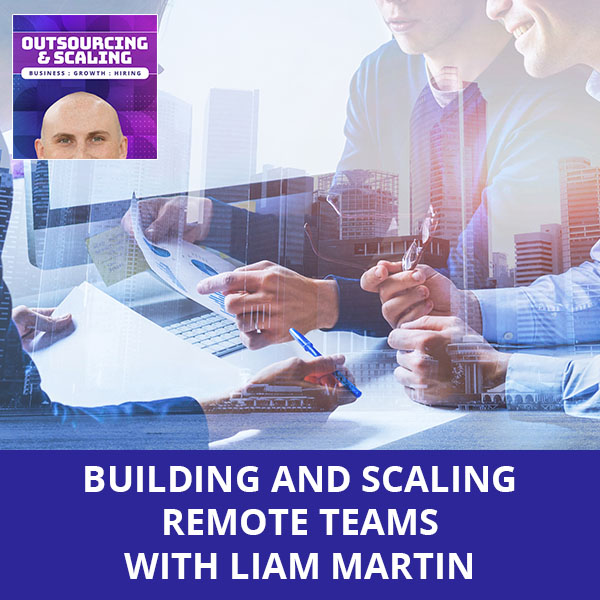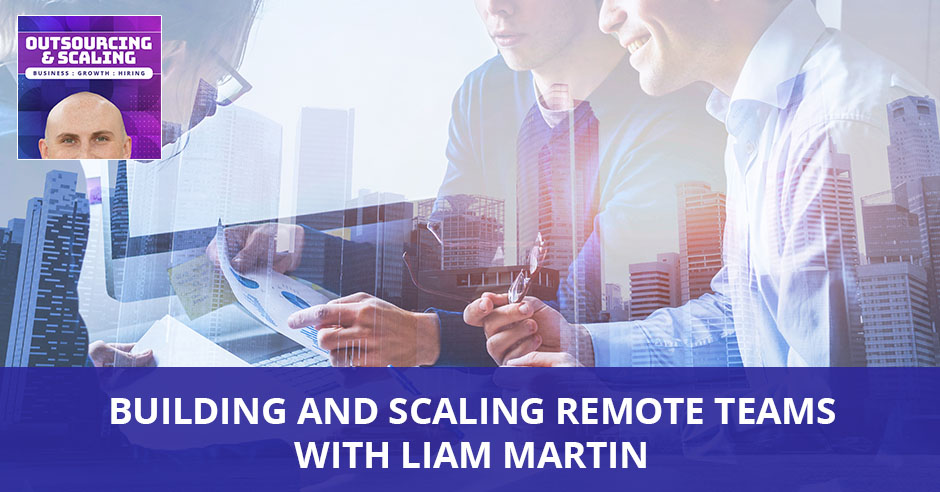


Many business owners have trouble making growing their business and scaling their remote teams the right way. Liam Martin, the Co-founder and CMO of TimeDoctor.com, has experienced this nightmare. Having developed the right mentality for hiring and managing remote teams, he shares his entrepreneurial endeavor and experiences in hiring people and explains the right way to figure out who your customers are and how to approach them.
—
Listen to the podcast here:
[smart_track_player url=”https://www.podetize.com/statsapi/www.podetize.com/wp-content/uploads/fileuploads/11-5b145ef137b51b3d1af0633e9305c43d/12/2019/c6b98393304e427899ff1d6e4082ac3a.mp3″ title=”Building And Scaling Remote Teams With Liam Martin” artist=”Nathan Hirsch” image=”https://freeup.net/wp-content/uploads/2019/04/OAS.png” ]
Download the audio file here.
Building And Scaling Remote Teams With Liam Martin
My guest is Liam Martin. Liam, how are you doing?
I’m fantastic. How are you doing?
I’m doing great. You and I talked a few years back when we were first starting the FreeUp marketplace. It’s been cool seeing you start up your conference and us growing FreeUp and meeting up again. For those of you that don’t know, Liam is the Cofounder and CMO of TimeDoctor.com. I know a lot of our clients use that, Staff.com and is a co-organizer of RunningRemote.com, the largest conference on building remote teams. After working with remote workers for several years, Liam works on furthering outsourcing and is passionate about how to gain insights into the inner workings and how people work. We’re going to talk all about that and more. First, let’s take a gigantic step back. What were you like growing up as a kid? Were you a straight-A student? Were you a rebel? Did you always know you wanted to be an entrepreneur?
I was a figure skater up until about the age of twenty in which I broke my kneecap and got kicked out of the Olympic Training Program and had a huge readjustment of my life. Up until that point, I was being bred for a specific purpose which was the Olympics, working and training internationally and then all of that fell apart. I was no longer a carded athlete anymore in Canada. You get a government stipend from the government if you achieve a certain level. They cut all that. I realized that I needed to figure out how to get into university pretty quick. I got to university and then ironically because of sports, I was a straight-A student because I had this huge chip on my shoulder. I had not finished high school and I thought, “They’re going to kick me out of this place.” If I have a 3.9 GPA, I’m out. I worked my butt off and ended up doing undergrad and graduate school. Also, I had another realization that getting a PhD wasn’t for me. I had that entrepreneurial feeling in the back of my neck that I didn’t want to spend the next 5, 6 years pursuing my PhD. I got out of that and then got back into entrepreneurship.
What was your first real entrepreneurial endeavor outside of maybe selling baseball cards or lemonade stand? What was your first project as an adult?
In grad school, after about seven years of being a teaching assistant, I was able to teach my very first class. The goal of graduate school was to teach. I’m very excited about it. I showed up for the very first lecture. I don’t know for people who have not been to university. You hand out the syllabus at university for your first lecture, you don’t actually teach. I thought, “I’m so good at teaching. I’m going to give these guys a three-hour lecture.” I went from 300 students to a little bit above 150. By the end of the year, I got the worst reviews in the history of the department. I realized that that wasn’t for me and which also connected to me quitting grad school.

What I learned from that was I didn’t like lecturing but I liked teaching. I turned that into a virtual tutoring company and grew that to 100-plus tutors throughout North America and Europe specifically targeting pre-med prerequisites. I built that company and sold it within a couple of years. Literally from that company, one of the major problems that I had was the ability to be able to measure how long someone worked for me. I’d have a student that would say, “You billed me for ten hours with this tutor but I only worked with this tutor for five hours.” I go to the tutor and say, “Did you work with Jenny for ten hours?” He’d say, “Of course, that’s why I billed ten hours.” I’d end up having to refund the student for five hours and pay the tutor for the full ten hours. This was a problem. That’s why with Rob, I cofounded Time Doctor which solved that problem for the previous business.
Can you talk about that first year starting a Software as a Service company? Are you a developer? Did you hire developers? How did you get that off the ground?
It’s with money. We’re bootstrapped but that’s disingenuous to be able to say I had some acquisitions and so did Rob. We were able to fund it. At that point, we were both nontechnical founders. Rob runs the development side of the house. I’m more of the marketing and sales side of the house. It was a hard grind. It was way back in the day, which was several years ago. It was a lot of doing long-term strategies like SEO, doing a lot of even forum posting, making sure that the software was solid, doing a little bit of paid advertisement and referral marketing. It’s a hard grind particularly with SaaS inside of this business model. It’s all about compound interest. SaaS starts slow but then arcs up and 70% of our business is through referrals. A lot of people think that SaaS is an outbound play. It’s not at all. It’s just build a good product, get people to enjoy that product and then they’ll share it with their friends. That’s the entire business model.
Let’s talk about hiring. You’ve hired people for the first business that you sold. You have lost people using Time Doctor for their hires. You have an internal team there. What is your mentality for hiring? What types of people do you look for?
Finishers are the biggest thing that I look for. I have a document for all of my direct reports which is entitled Liam and His Little Quirks which are nine very truthful statements about me. I would go out and talk to their three closest friends as an example and I would ask them this question, “What would you say to someone that’s about to meet you if you were going to work with them?” They then told me and then that’s what I would put together in that document. A lot of those things are maybe things that I wouldn’t necessarily say about myself. A lot of that stuff is not necessarily the nicest stuff to say but it’s very truthful. The thesis statement of this document is I’d rather you make the wrong decision than none at all. We have contractors in 32 different countries all over the world. We have over 100 people that work inside of Time Doctor. It’s important for people to make their own decisions without direct management oversight. We look for people that can take action, move the rock forward regardless of whether you’re moving the rock in the wrong direction because every decision is reversible within twelve hours.
It’s better that you make the wrong decision than none at all, because every decision is reversible within twelve hours.
What about any bad hires? Any horror story that stands out to you? I’m sure you fired people but is there any one particular story that stands out?
For us, we have a philosophy. Our retention is pretty high. Our termination rate in 2018 is I believe 4%. A lot of the time, it’s someone stole from the company. Someone was trying to steal data outside of the company and that’s an automatic termination, but in terms of the wrong fit, they know that it’s the wrong fit about 2 to 3 quarters before that termination happens. A lot of the time, we sit down and say, “Do you want to take another quarter stab at this? You’re not hitting your numbers. I’m trying to help you as much as humanly possible but it doesn’t seem like it’s working where we’re at.” With A players, they’ll be the first ones to say, “This isn’t working. I should be doing something else.”
That’s a great approach. A lot of people go into those meetings being like, “You need to step it up. You better hit your numbers.” The better approach that people are higher-level leaders talk about is, “What can I do to help you? What am I not doing right? How can I support you to get better?” Maybe there is something small that you can change or you can do to make it clearer to communicate better but a lot of times, they might know it’s not the right fit and there’s nothing that you can do.
There’s a great book that you can pick which is a Radical Candor by Kim Scott. That was my personal problem in terms of management. I would not be radically candid with people right up-front. The definition of that is if I saw that your fly was undone, I’d be like, “Nathan, your fly.” I’ll keep it quiet. It’s being radically candid telling you there’s a very specific problem but I’m here to help you. My job is to be able to make you successful as a direct report. How can I get you to your goals? If I can’t get you to your goals then we can’t keep you in the company but I’m here to be able to work with you. That’s a very non-aggressive way to be very direct and also make sure that no termination conversation is ever a surprise. If it’s ever a surprise with a contractor, you did not do your job as a manager because if they didn’t know that that was coming, that’s a major problem up for you.
What are some other mistakes that you see entrepreneurs are doing when hiring virtual assistants, freelancers and remote people?
Lack of process documentation is the largest and most problematic issue that we see. The ability to be able to hire people and have proper process documentation is completely different in remote-first companies versus on-premise companies. In an on-premise company like in an office that I would be in now, I would be able to show you, Nathan, how to do my particular task the way that I want you to do it, but when you are 10,000 miles away, you can’t do that. You need documentation that you can digitize, put up in a platform and then anyone can go in, grab that information regardless of whether or not I’m in the same time zone and then you can get that feedback. That’s the biggest problem that I see with remote-first companies. Most large corporate companies already have this type of documentation but remote-first has to act like a Fortune 500 a lot faster.

I’ll ask you a question that I get a lot and I’m curious on your answer. When is the right time for someone to consider hiring or start hiring?
That’s an interesting problem. It depends on your different department but I would not be caught behind the crosshairs of I now need to do this massive project and I don’t have the capacity in place. We hire internally. We’re doing about half a dozen hires a month. For us, if we’re ever caught in a particular month where we need to hire someone to do a job inside of that month, then recruitment in HR is failing. We need to figure out what are the next hires that we need to have down the pipe because we need a new BDR, a new researcher, a new marketing person or a developer. We need to onboard that person for three months before they’re useful inside of the business. We need to think two to three quarters down the road, “Who do we need to hire right now,” and we need to start putting in those specs to be able to make it happen. That’s the biggest problem that I see. People are saying, “I need to hire 82 people right now and I have a 20% headcount.” That’s a disaster. Anyone that hires more than 50% of their headcount plus 50 people is in a big problem because you’re going to lose the company culture so people are going to get hired that you’re not going to be directly connected to. Hiring is one of those things that for us takes a very long time to do.
I want to talk about your conference Running Remote and I want to start off by asking you what is your opinion on remote? Should every business be doing that in 2019? Are there certain businesses that should definitely have an office? What are your thoughts on that?
It’s 7% of the US workforce and it’s projected to be 50% within the next couple of years. If you are not working remotely or if you don’t have a remote work agreement in place, you will be left out in the next couple of years. 86% of developers as an example in the United States work remotely. This is something that is not a happy little trend. This is something that’s going to become the dominant way that people work. Generally and most studies will show that remote work makes contractors 20% more productive and it increases retention by approximately 30%. That in essence communicates happier, better contractors. It is the single thing that you can do to be able to make your contractors the happiest out of anything else. It’s all the free lunches in the world cannot get away from working remotely.
For us, building the conference, we saw that as something that we wanted to champion and to talk about in a deeper way because no one is really talking about that. We said to ourselves, “Let’s build this conference,” because I was looking for something that served me. There are tons of conferences about being a digital nomad as an example. Generally, running a tech business but there’s nothing about, “I have 100 contractors. I need to get to 150 contractors and run our first company.” Marcie Murray as an example, who’s the Director of Support for Shopify, spoke and she had her talk about how she went from zero to 2,000 remote support reps in three years. Those are the stories that I find inspiring and the ones that I can learn from because that’s where I want to be in the next couple of years.
In any business, you have to figure out who your customer isn’t as opposed to who your customer is.
I work with a ton of remote businesses, I’ve heard nothing but good things about your conference. People should definitely check it out. Any other information you can share about the conference, about what people can expect or what people should attend?
It’s not designed for people that don’t manage other remote workers. I need to get super laser-focused. In any business, you have to figure out who your customer isn’t as opposed to who your customer is. We are not a conference for digital nomads. If you don’t manage any remote contractors, it’s not the conference for you. If you are a company that’s looking to go remote, then this conference is for you. If you run what we call Remote-first Company, then this conference is definitely for you. It’s everything that you could possibly learn about building and scaling remote teams.
Especially if you’re using virtual assistants, freelancers, remote agencies however you’re structuring your company. Liam, this has been awesome. Where can people find out more about you and what are you looking forward to the rest of the year?
You can go to TimeDoctor.com to check out Time Doctor and RunningRemote.com to check out Running Remote.
Thank you again for coming on.
Important Links:
About Liam Martin
 Liam Martin is the co-founder and CMO of TimeDoctor.com, Staff.com and is a co-organizer of RunningRemote.com the largest conference on building remote teams.
Liam Martin is the co-founder and CMO of TimeDoctor.com, Staff.com and is a co-organizer of RunningRemote.com the largest conference on building remote teams.
After working with remote workers for over 10 years, Liam works on furthering outsourcing and is passionate about how to gain insights into the inner workings of how people work.
